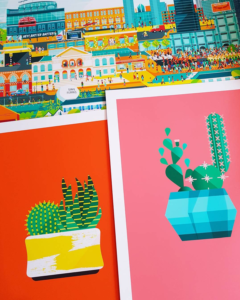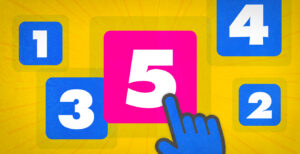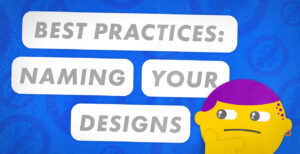“Make things and show people.”
– Ben the Illustrator
Trying to get your products and designs out there can be frustrating. And sometimes, we need someone to remind us why we do it in the first place. And Ben the Illustrator is that perfect someone. His colorful art takes you on a visual journey, and the enjoyment he gets out of creating his work is completely contagious. And now, he’s even become a charity curator for his Artist Shop, COUP Tees – a shop that offers designs from various illustrators (including Andy J. Pizza) who create a design and choose an organization, non-profit, or charity for the proceeds from their design to be donated to.
We talked to Ben about everything from the benefits to designing apparel for a charity (both for them and for you), about how he found his clean and beautiful style, and about how art has helped him personally get through mental health struggles. Check out the interview below and get inspired!
. . .
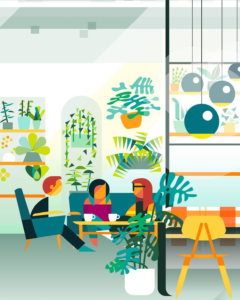
Between Nickelodeon, The New York Times, and GQ, you’ve created art for some huge brands! What project has gotten you most excited?
I do feel lucky to have worked with some great people over the years. I think the most exciting project was an ad campaign for Berri Fruit Juice in Australia back in 2010. I created a set of 20 refreshing illustrations which took over every ad space in all the major city train stations, so I designed patterns which went on the floor, banners, billboards, right down to little ads on signposts and along the walkways. It was amazing to bring colour to so much space. They treated it very much like an exhibition of my refreshing and dynamic landscapes and animal illustrations. My work has actually evolved in style a lot since then, but it was a dream.
I think the biggest learning curves come from projects where I’m bringing my illustration work to an area that’s new to me. For example, interactivity or products. The biggest of which is B-Goods; a brand owned by my wife and I. In creating our stock, I had to go from learning how to create a repeat pattern to learning the manufacturing processes for ceramics and wallpapers, and colour matching on textiles and art prints.
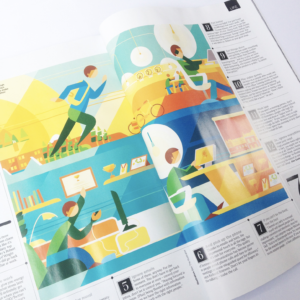
You got your start as an animator; what made you shift from ‘Ben the animator’ to ‘Ben the illustrator’?
When I studied animation, unfortunately we were focused on traditional in an era when digital was completely taking over! I worked as part of a small animation and design studio in London. It was great, but I started to realise that our freelancing animators were far better than I could ever be, and my only passion was how everything looked; not necessarily how anything moved or how a story was told. I started taking on some illustration jobs on the side, and it grew from there. Within a year, I had left the studio to become ‘Ben the Illustrator’.

In your first year as an illustrator, you were already doing work for Vice and Yahoo! How did you first start getting traction for your work? How did you market yourself?
To be honest, I was lucky to be coming out of an animation and design studio where I already had some contacts (the work for Yahoo!, for example). I think it came down to being very excited about my newfound career; I lived in London and just wanted to get everything out there. I focused on getting a really solid, colourful website together and kept my eye out for every opportunity; going to design shows and events, getting into indie art and illustration magazines…it was a really great time and anything felt possible. The Vice work was really great – creating artwork for Smart Car advertisements they ran in Vice magazines worldwide. I think I saw an ad looking for artists and worked my butt off to put together a killer proposal, which got me the job. That project ended up running for two or three years in the end!
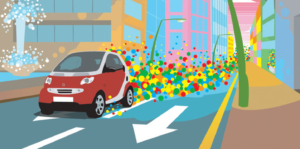
You have such a distinct style! Where do you draw inspiration from? What are your thoughts on having a distinct, consistent style and how did you find yours?
THANKS! To be honest, not much of my inspiration comes from illustration. I spend a lot more time looking at fine art, especially graffiti and Pop Art, and also fashion, furniture design, and architecture. My style has evolved over the years, sometimes towards a more realistic look, but I nearly always come back to something quite graphic with nice clean lines and geometric shapes. I have to admit, over recent years I’ve found that my own mental health has progressed my style. I have suffered from depression since I was a teenager, and creating clean graphic artwork – especially in vectors – is very therapeutic to me. It keeps my mind busy and focused on one simple act.
Sometimes I use mathematics to bring an illustration together. For example using number patterns to space out objects in a composition, or using calculating CMYK values to create colour palettes. Up until two years ago, I was still working in varying styles, but I decided it was all too confusing and streamlined by portfolio right down to the purer graphic work, and it has been far better to promote myself and show potential clients what I do. It’s important to have flexibility in what you’re able to illustrate, but I do think that a consistent thread or style through your portfolio will help you.
I have to say though, newer illustrators or students shouldn’t feel pushed to find their style; it will come. If you’re starting out, you should enjoy experimenting and trying everything. Your style will start to come out of where your skill strengths are balanced out with what you simply enjoy creating.
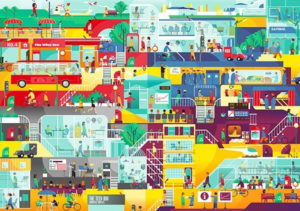
I love the geometric and clean look of your work. What’s your creative process from concept, to page, to computer?
Ideas can come from anywhere. Sometimes I’ll spend time writing words and thoughts until an idea comes, sometimes a client already knows what they want, sometimes it’s from my wife Fi (we often work together – she’s a concept genius), and sometimes it’ll come to me on a walk. As soon as an idea starts to form, I start drawing. I always go to pencil and paper, I think better on paper (as opposed to drawing on a digital device). Bonus little ideas come while I’m drawing. I’ve started to draw more and more geometrically than I used to, so using a ruler and circle templates, even for a rough sketch. With a completed drawing, I’ll scan it and take it into Adobe Illustrator, which feels like second nature to me, it’s hard work to get started with vector artwork, but once you conquer it it is such a satisfying tool. I’ll trace all the linework and then on to the fun bit of adding colours and the occasional texture, pattern or gradient.

You have an Artist Shop with us, too – COUP Tees! Is apparel a medium you’ve worked with before? What are some of the benefits of putting art on apparel and accessories?
I have done a few apparel projects, but it really is an area I’d like to be doing a whole lot more of. I’ve designed a handful of t-shirts, so I know I need to do a whole lot more (I will be adding to the COUP store sometime soon!) I’ve been lucky to design shoes for Bucketfeet and a cycling jersey for Milltag, which have been incredible experiences. I think the main benefit is seeing your work in a different way, considering different functions and surfaces beyond the screen or printed paper.
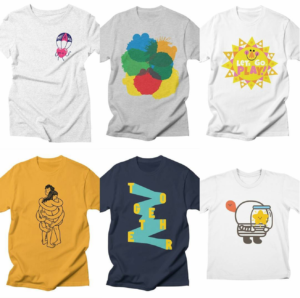
Is creating art and illustration for charities and non-profits something you’d recommend to artists to get their work out there in a positive way, but also for visibility?
Oh yes, absolutely. Whether it’s to raise awareness or to fundraise in some way. I get a lot of requests to work for free for clients, which I can’t stand and will always turn down (as they could be profiting off your work while offering you ‘exposure’ as some kind of payment!) But why aid a business (if you’re not profiting anyway) when you could aid a good cause, charity or event! It also shows a little about you as a person: if you’re really into nature, then do something for an environmental cause. If you’re dedicated to human rights, then make a protest sign, or if you’re a keen vegan do something to promote the issues. Do some good, and tell people a little more about yourself.
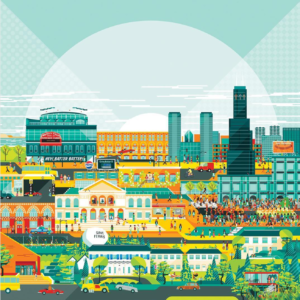
You crush it on the social media front! A lot of artists struggle with what to post on social media and with gaining an audience. What are your tips for creating some killer social media content?
Don’t worry about anything, don’t preempt what people might think. If you believe in a piece of content, put it out there. You don’t have to please everybody with mediocre mainstream artwork that’s the same as everyone else’s; it’s more important to focus on what you want to put out there and how special you are, and you’ll attract likeminded people. A thread of continuity can help; people have told me that they follow me for the colors. They like that I bring some colour to their feed. Likewise some people bring humour, or serious issues, or inspiring technical skills. It’s a good idea to try and be regular (although I falter on this and can go a week without posting to Instagram). Also, interacting with other people’s posts is just as important as your own posts, so comment, start conversations, tell people how cool their latest content it, build up relationships and soon enough you’ll find a supportive community that will help you get your work out there more and more.
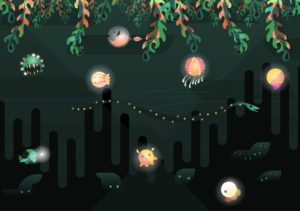
What, to you, are some of the keys to becoming a successful illustrator?

Be exciting. If you’re not excited about the prospect of being an illustrator for life, then it’s just not for you. It can be an unstable profession, jumping from one commission to the next, but excitement in creating your own work drives you through that. If you’re excited about your own work, people will feel that and will be excited to work with you. If they feel that you’re excited to work with them, they’ll come back to you again and again.
Beyond good vibes and dedication, you need to keep your marketing up; always update your portfolios, tell people about your work, email potential clients, don’t expect everyone to find you – you need to stand out and put your work in front of the right people. Make things and show people.
Anything else you’d like to share?
I’d like to publicly vow to create a t-shirt design for COUP asap! Please do check out all the awesome charity t-shirts we have on there!
. . .
Featured illustration by Katie Lukes
Feeling inspired? Try Artist Shops for free and start your own creative journey!

